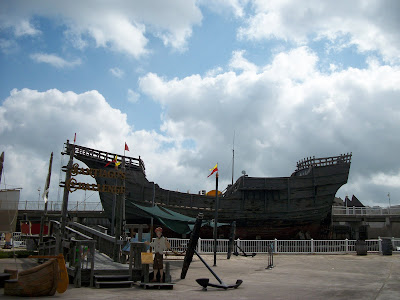Although Columbus himself never explored this area, Corpus Christi won a bid to house replicas of La Niña, La Pinta, and La Santa María that were built in Spain in 1992 to commemorate his voyage of discovery five hundred years before. Apparently, the replicas crossed the Atlantic and toured several coastal cities in the United States, but completely avoided any of the places that Columbus actually explored! At the end of their voyage, the city of Corpus Christi docked them at the entrance to the bay. A year later a big cargo ship smashed into two of them! La Pinta and La Santa María, no longer seaworthy, are now dry docked at the museum where they are available for tours while they await repairs.
Here is La Niña, which visitors are allowed to board under the supervision of a tour guide.
La Santa María is apparently not in good enough shape to board right now, but you can get close enough for pictures.
While tours of these two replicas are part of the cost of admission to the museum, La Niña can be seen free of charge where it is docked next to the yachts on Ocean Drive. Although still seaworthy, it is also in need of repairs.
There are a number of exhibits inside the museum related to Spanish maritime exploration. The most important is about a 1554 shipwreck off the coast of South Padre Island. The exhibit includes life-size models of ships, a movie dramatizing the shipwreck, and numerous artifacts excavated from the site. Here is the keel from one of the ships:
I don't have other pictures because the exhibit was indoors, but it is extremely fascinating and well worth the visit. There is another exhibit about the Belle, another ship sunk in Texas waters. Although the Belle was commanded by a French explorer, La Salle, its 1684 voyage is extremely relevant to Texas's Spanish colonial history. News of this French incursion motivated Spain to establish the string of missions in East Texas as a buffer zone. I stopped on the way home to snap a picture of Matagorda Bay, where the Belle was excavated:
Artifacts from the Belle are scattered among several museums in Texas, so there are only a few in Corpus Christi. This didn't stop the curators from constructing an awe-inspiring exhibit space for them, which includes a magnificent fifteenth-century mudéjar-style ceiling transported from Spain:
Most people go to Corpus for the sea and sand:
The best way to avoid the crowds and imagine how this area would have looked before there were hotels, however, is to explore the maritime exploration exhibits at the Corpus Christi Museum of Science and History.



























